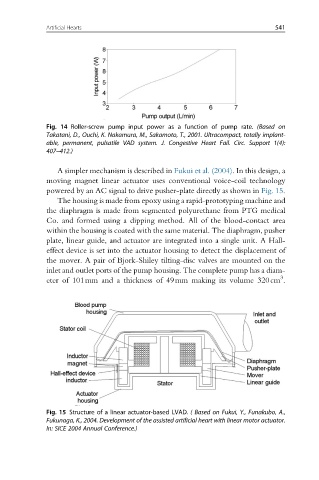Page 547 - Handbook of Biomechatronics
P. 547
Artificial Hearts 541
Fig. 14 Roller-screw pump input power as a function of pump rate. (Based on
Takatani, D., Ouchi, K. Nakamura, M., Sakamoto, T., 2001. Ultracompact, totally implant-
able, permanent, pulsatile VAD system. J. Congestive Heart Fail. Circ. Support 1(4):
407–412.)
A simpler mechanism is described in Fukui et al. (2004). In this design, a
moving magnet linear actuator uses conventional voice-coil technology
powered by an AC signal to drive pusher-plate directly as shown in Fig. 15.
The housing is made from epoxy using a rapid-prototyping machine and
the diaphragm is made from segmented polyurethane from PTG medical
Co. and formed using a dipping method. All of the blood-contact area
within the housing is coated with the same material. The diaphragm, pusher
plate, linear guide, and actuator are integrated into a single unit. A Hall-
effect device is set into the actuator housing to detect the displacement of
the mover. A pair of Bjork-Shiley tilting-disc valves are mounted on the
inlet and outlet ports of the pump housing. The complete pump has a diam-
3
eter of 101mm and a thickness of 49mm making its volume 320cm .
Fig. 15 Structure of a linear actuator-based LVAD. ( Based on Fukui, Y., Funakubo, A.,
Fukunaga, K., 2004. Development of the assisted artificial heart with linear motor actuator.
In: SICE 2004 Annual Conference.)

